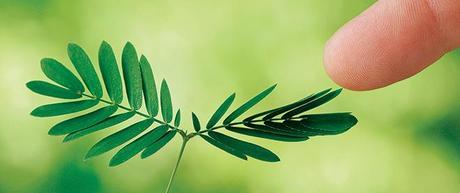
Source
First up, this recent article from Maclean's Magazine, entitled "Shh... the plants are thinking". To give a basic summary, the article discussed some studies that were conducted to show that plants can "keep time, count, and know themselves". Before you get too excited, there has been some controversy in the field over certain terms and whether certain experiments actually exhibited what they claimed to be studying. Here's a general breakdown of some of the historical and recent findings listed in the article:-Charles Darwin claimed that plant roots spread through the soil in a fine network much like a brain-like organ, in hisThe Power of Movement in Plants (1881).
-
Frantisek Baluska, a plant biologist at University of Bonn, as well as Stefano Mancuso, professor of horticulture at the University of Florence, are convinced that plant cognition occurs in the root tips—that "roots act like a distributed information-processing network, similar to the neural networks that organize information in computers".-
Susan Murch, associate professor of chemistry at UBC-Okanagan, has been studying the chemical connections between plants and human brains as both make and use the same compounds.-
Baluska has compiled work showing that plants produce painkillers, such as the plant stress hormone ethylene, as well as ether. "Both compounds reversibly render humans and animals unconscious, and make plants unresponsive to stimuli". Murch calls the chemical signals generated by wounded plants “screams.”-
Monica Gagliano of the University of Western Australia has looked into "Plant Learning". "Learning means that an organism can distinguish one kind of event from another, that it can remember, and adapt its behavior... Gagliano applied to plants test methods devised to study animal learning. Mimosa plants curl their leaves instantly if touched by something they interpret as a threat. She trained mimosa plants to recognize that being dropped from the lab bench was no threat. She dropped each plant 60 times, then introduced a new de-habituating threat (a vigorous shake) to be sure they distinguished one type of event from the other. Then she dropped the plants 60 times more. She found they stopped curling their leaves after about four drops and remembered the lesson up to 50 days later".These pieces give a quick summary of some of the research discussed in the article, which can be found in the link above. However, these studies have received criticism under peer review for being a desperate cry for publishing or for being inaccurately measured. Other science journals disagree with certain terms being used, such as "learning" with regards to plants, even if these studies do have a significant weight in quality research.

This lead to Alison and Martin's hypothesis that the plants were dividing one quantity by another. Martin commented that, “It didn’t seem to matter how we tried to mess up the plants and the sunlight regimes to which they're exposed, whether we gave them early nights, late nights, whether we altered the intensity of light during the day. We tried lots of things to try to interfere with this process but whatever we did, the plants seem to be able to rebudget appropriately. They would always get the right rates of degradation during the night, so they'd run out of their food reserves at dawn. The only way this seems to be consistent with our data and to be able to do that in all circumstances, was that they were really doing this division calculation, that they knew, that plants knew how much starch they have. They’ll have information about how much time there was to dawn and they would divide these two numbers together to work out the right rate to eat up their starch.”
Pretty interesting when you really think about it. It gives a bit of a different perspective on life in general, and just how much we actually know about what's out there. It looks like we have a lot more to learn about, especially when it comes to our own planet. Hopefully this was a bit of an eye opener for you as it was for me. I have always felt a need to care for the underdog, those who have no voice, hence my concern for environmental issues. But, to see the different types of intelligence there is, even in plants, is a new thought worth thinking.
All information was taken from both linked sources above and have been quoted accordingly.
